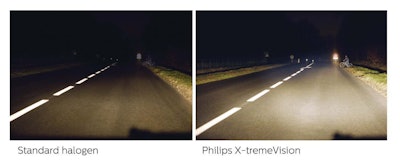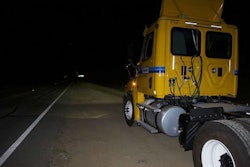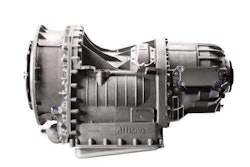 Illustration courtesy of Phillips.
Illustration courtesy of Phillips.In-cab LED lighting is becoming standard across many OE lineups, but is still largely an option as you work your way to the front of the vehicle in most cases.
Daimler Trucks North America announced almost three years ago that Truck Lite Custom LED headlamps would be offered as standard equipment on all Cascadia and Cascadia Evolution models. Volvo has made in-cab LED lighting standard on the interior and exterior of its vehicles. Optional LED headlights are available on VNL and VNX models.
Other OEs have poured efforts into beefing up halogen technologies, or gone in another direction altogether.
The Peterbilt 587 offers standard halogen lights but re-engineering bumped brightness by 35 percent and bulb life by 79 percent. Optional high-intensity discharge (HID) headlamps increase brightness by 220 percent. Ditto for Kenworth’s T680, which also gets LED exterior lights.
With some noted exceptions, most trucks get standard halogen headlights when they roll off the line. While effective in the short-term, bulbs used in halogen headlights can start to break down with exposure to the elements and everyday usage, dramatically reducing visibility as a result.
Drop-in LED replacements have become fairly commonplace on trailer brakes and turn signals where frequent bumps and jarring can render rear lamps dark, but they are still largely an aftermarket add-on the front of the truck. In 2013, Penske retrofitted 5,000 tractors with Truck-Lite LED headlights.
According to the National Safety Council, traffic death rates are three times greater at night than during the day, even though roads tend to be less congested after sundown than they during the day.
Much of that can be placed on tired drivers, but that the visual acuity of the human eye is reduced by up to 70 percent at night makes the reduced visibility associated with older halogen headlights a legitimate safety concern.
A recent study from the AAA motor club found that the halogen headlights used in more than 80 percent of the vehicles on the road today fail to safely illuminate unlit roadways, even when vehicles are traveling as slow as 40 miles per hour.
In late 2013, CCJ took one of Penske’s retrofitted units for a test drive on some of Alabama’s rural roads and found their performance to be above standard with several noted benefits.
A recent report from Federal Motor Carrier Safety Administration’s Analysis Division shows a 33 percent decrease in combination trucks involved in injury crashes going back to 1994. Much of that has to do with safety improvements and regulations made across the board, but improved lighting will go a long way in making sure that downward trend continues in the years ahead.












